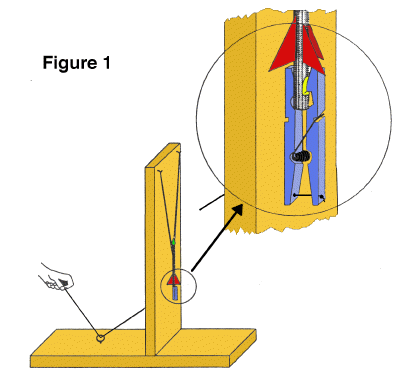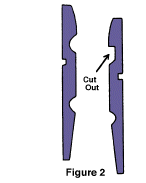Pencil Rockets
SUBJECT: Space Flight
TOPIC: Rockets
DESCRIPTION: Rockets, using pencils for their bodies, are launched with a rubber band-powered launch platform.
CONTRIBUTED BY: Gregory Vogt, OSU
EDITED BY: Roger Storm, NASA Glenn Research
 MATERIALS and TOOLS: MATERIALS and TOOLS:
- 2 Pieces of wood 3'X4"Xl" in size
- 2 Cup hooks
- 1 Wooden spring clothes pin
- 1 Small wood screw
- 1 Screw eye
- 2 Metal angle irons and screws
- 4 Feet of heavy string
- Iron bailing wire (18 gauge minimum)
- Several rubber bands
- Several wooden pencils (unsharpened)
- Several pencil cap erasers
- Cellophane or masking tap
- Heavy paper
- Saw
- Wood file
- Drill (3/16 inch diameter)
- Pliers
PROCEDURE
Launch Platform
- Join the two pieces of wood as shown in the diagram to form the launch platform. Use a metal angle iron on each side to strengthen the structure.

- Screw in the cup hooks and screw eye into the wood in the places indicated in figure 1.
- Temporarily separate the wooden pieces of the clothes pin and file the "jaw" of one piece square as shown in figure 2. Drill two holes through the other wood piece as shown. Drill one hole through the first wood piece as shown.

- Drill a hole through the upright piece of the launch platform as shown and screw the clothes pin to it so that the lower hole in the pin lines up with the hole in the upright. Reassemble the clothes pin.
- Tie a knot in one end of the string and feed it through the clothes pin as shown in figure 1, through the upright piece of the platform and then through the screw eye. When the free end of the string is pulled, the clothes pin will pen. The clothes pin has become a rocket hold-down and release device.
- Loop four rubber bands together and loop their ends on the cup hooks. The launch platform is now complete.
Rocket
- Take a short piece of bailing wire and wrap it around the eraser end of the pencil about one inch from the end. Use pliers to twist the wire tightly so that it "bites" into the wood a bit. Next, bend the twisted ends into a hook as shown in figure 3.

- Take a sharp knife and cut a notch in the other end of the pencil as shown in figure 3.
Figure 3
- Cut out small paper rocket fins and tape them to the pencil just above the notch.
- Place an eraser cap over the upper end of the rocket. This blunts the nose to make the rocket safer if it hits something.
The rocket is now complete.
LAUNCHING PENCIL ROCKETS:
- Choose a wide open outdoor area to launch the rockets.
- Spread open the jaw of the clothes pin and place the notched end of the rocket in the jaws. Close the jaws and gently pull the pencil upward to insure the rocket is secure. If the rocket doesn't fit, change the shape of the notch slightly.
- Pull the rubber bands down and loop them over the wire hook. Be sure not to look down over the rocket as you do this in case the rocket is prematurely released.
- Stand at the other end of the launcher and step on the wood to provide additional support.
- Make sure no one except yourself is standing next to the launch pad. Count down from 10 and pull the string. Step out of the way from the rocket as, it flies about 75 feet up in the air, gracefully turns upside down and returns to Earth.
- The rocket's terminal altitude can be adjusted by increasing or decreasing the tension on the rubber bands.
DISCUSSION: Like the flight of Robert Goddard's first liquid fuel rocket in 1926, the pencil rocket gets its upward thrust from its nose end rather than its tail. Regardless, the rocket's fins still provide stability, guiding the rocket upward for a smooth flight. If a steady wind is blowing during flight, the fins will steer the rocket towards the wind in a process called 'weather cocking.' On NASA rockets, active controls steer during flight to prevent weather cocking and to aim them on the right trajectory. Active controls include tilting nozzles and various forms of fins and vanes. |


 MATERIALS and TOOLS:
MATERIALS and TOOLS:
